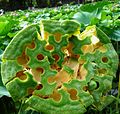Indian lotus flower
| Indian lotus flower | ||||||||||||
|---|---|---|---|---|---|---|---|---|---|---|---|---|

Indian lotus flower ( Nelumbo nucifera ) |
||||||||||||
| Systematics | ||||||||||||
|
||||||||||||
| Scientific name | ||||||||||||
| Nelumbo nucifera | ||||||||||||
| Garden. |
The Indian lotus flower ( Nelumbo nucifera Gaertn. , Syn . : Nelumbium speciosum Willd. , Nymphaea nelumbo L. ) is a species of lotus flower ( Nelumbo ) in the lotus family (Nelumbonaceae).
features
The Indian lotus flower is a runners-forming, perennial herbaceous water plant . The stalked leaves are peltat. The leaf stalks are 2 m or more long. The round leaf blade is 60 cm or more in diameter.
The hermaphroditic flowers are radial symmetry . The many 1 to 13 cm long bracts are pink, tinted pink or white (in some varieties also yellow) and obsolete. The anthers are 1 to 2 cm long. There are many free carpels . For pollination , the flower uses a temporal gender separation, i. H. the female sexual organs (carpels) mature before the male ones (anthers). In addition, the bowl-shaped inflorescences warm up. Since nectar is not offered, it is believed that in addition to the scent, bees, flies and some bugs are attracted by the heat.
The flower axis tapers evenly towards the base at the time of fruiting and is often slightly rounded above the flower stalk. The egg-shaped fruit has a size of 10 to 20 × 7 to 13 mm. The nut fruits are egg-shaped or ellipsoid, measure 10 to 20 × 7 to 13 mm and are more than 1.5 times as long as they are wide and sunk into the flower axis.
The number of chromosomes is 2n = 16, less often 24.
Occurrence
The Indian lotus flower originally came from India to Japan , south to Korea and the north of Southeast Asia , but also isolated in the area of the Aral Sea and Caspian Sea . The plant was spread by humans south to northeast Australia and North and South America .
use
The tubers are dried and made into flour or cooked and served with vinegar and soy sauce as a side dish. Young leaves and petioles are cooked as vegetables. The seeds are eaten fresh as lily buds , candied or roasted as a snack or cooked as a side dish. So far only in Myanmar is lotus silk made from the plant fibers.
Individual evidence
- Jump up ↑ JK Li, SQ Huang: Effective pollinators of Asian sacred lotus (Nelumbo nucifera): contemporary pollinators may not reflect the historical pollination syndrome. In: Annals of botany. Volume 104, number 5, October 2009, pp. 845-851, doi : 10.1093 / aob / mcp173 , PMID 19617594 , PMC 2749538 (free full text): Notes on the fertilizing insects
- ↑ Nelumbo nucifera at Tropicos.org. In: IPCN Chromosome Reports . Missouri Botanical Garden, St. Louis
- ↑ Notes on the history of distribution
- ↑ Dericks-Tan and Vollbrecht: "On the trail of wild fruits in Europe". Abadi Verlag Alzenau, ISBN 978-3-00-021129-4 , p. 145
literature
- Eckehart J. Jäger, Friedrich Ebel, Peter Hanelt, Gerd K. Müller (eds.): Rothmaler excursion flora from Germany. Volume 5: Herbaceous ornamental and useful plants. Spectrum Academic Publishing House, Berlin Heidelberg 2008, ISBN 978-3-8274-0918-8 .
- John. H. Wiersema: Nelumbonaceae in the Flora of North America , Volume 3: Nelumbo nucifera - Online.









